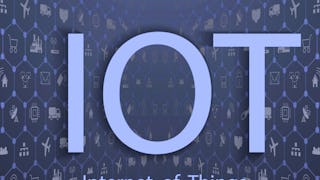Dive into the world of IoT system architecture with a course that doesn't just teach you the "how," but also the "why." Learn the art and science of building robust, scalable, and interoperable IoT systems. This five-week course takes you on a comprehensive journey from understanding the imperative of well-planned architecture to mastering the nuances of quality attributes and scenarios.


Software Architecture for the Internet of Things

Instructor: Frank Gielen
28,018 already enrolled
Included with
(250 reviews)
Skills you'll gain
Details to know

Add to your LinkedIn profile
See how employees at top companies are mastering in-demand skills

There are 5 modules in this course
This module will introduce you to the world of software architecture. We'll define what SA actually is, why it is important and talk about some of the challenges faced in modern Software Engineering. This course is also part of a Blended Master Programme in Internet of Things through Embedded Systems.
What's included
6 videos6 readings2 assignments2 discussion prompts
Creating good software starts with a solid understanding of the requirements that will have an influence on the software. In this module, we will discuss both functional and non-functional requirements, such as quality attributes, business requirements and constraints.
What's included
8 videos7 readings4 assignments2 peer reviews4 discussion prompts
Up till now, we have been talking about quality in an informal way. However, if you want to build systems that support the required qualities you will need a way to express those quality attributes and understand how you can achieve them. After this module you should be able to formulate your own quality requirements. We will also study 2 qualities that are especially relevant for Internet of Things: interoperability and modifiability.
What's included
7 videos1 reading3 assignments3 peer reviews2 discussion prompts
In the fourth week, we will explain how architectural tactics can help you create a software architecture that achieves the predefined requirements. This is what needs to be done in step three of the ADD - remember? We'll start of by learning about the difference between tactics and patterns. We will give some examples of tactics to achieve interoperability and modifiability. We will discuss the MVC pattern and its relation to the modifiability tactics. Lastly, we'll discuss how MVC is being used in Android.
What's included
5 videos2 readings1 assignment1 peer review
In this last week, we will explain how architectural patterns can help you create a software architecture that achieves the predefined requirements. Patterns are closely related to tactics, as we saw last week. First, we'll look at different types of patterns. Then, we'll learn how to combine tactics and patterns. We'll conclude this last week with a case study: DYAMAND's requirements and their architecture.
What's included
5 videos2 readings1 assignment4 peer reviews3 discussion prompts
Instructor

Offered by
Explore more from Software Development

28DIGITAL
 Status: Free Trial
Status: Free TrialLearnQuest
 Status: Preview
Status: PreviewPohang University of Science and Technology(POSTECH)
Why people choose Coursera for their career




Learner reviews
250 reviews
- 5 stars
61.20%
- 4 stars
24%
- 3 stars
8%
- 2 stars
1.60%
- 1 star
5.20%
Showing 3 of 250
Reviewed on Sep 19, 2023
I registered my project a few weeks ago. But I did not receive an answer or confirmation. Is no one checking? for week 2 . please help me thank u
Reviewed on Dec 5, 2023
It's very helpful and very important Thanks for the work that you are guys doing I appreciate it
Reviewed on Jul 1, 2018
Quite interesting from the IoT course I did in 2016 on EDX: ColumbiaX DS101x-103x

Open new doors with Coursera Plus
Unlimited access to 10,000+ world-class courses, hands-on projects, and job-ready certificate programs - all included in your subscription
Advance your career with an online degree
Earn a degree from world-class universities - 100% online
Join over 3,400 global companies that choose Coursera for Business
Upskill your employees to excel in the digital economy
Frequently asked questions
To access the course materials, assignments and to earn a Certificate, you will need to purchase the Certificate experience when you enroll in a course. You can try a Free Trial instead, or apply for Financial Aid. The course may offer 'Full Course, No Certificate' instead. This option lets you see all course materials, submit required assessments, and get a final grade. This also means that you will not be able to purchase a Certificate experience.
When you enroll in the course, you get access to all of the courses in the Specialization, and you earn a certificate when you complete the work. Your electronic Certificate will be added to your Accomplishments page - from there, you can print your Certificate or add it to your LinkedIn profile.
Yes. In select learning programs, you can apply for financial aid or a scholarship if you can’t afford the enrollment fee. If fin aid or scholarship is available for your learning program selection, you’ll find a link to apply on the description page.
More questions
Financial aid available,
¹ Some assignments in this course are AI-graded. For these assignments, your data will be used in accordance with Coursera's Privacy Notice.


